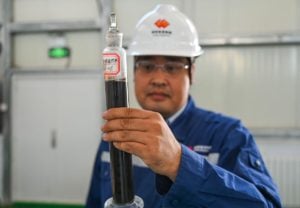When the National Bureau of Statistics released China’s key economic and social data for 2023 at the end of last month, an apparent technicality had even greater significance than the numbers themselves. Yet it went almost completely unnoticed.
The bureau said energy consumption had grown faster than GDP (gross domestic product), but that energy intensity had fallen by 0.5%. This seeming paradox is due to the government recently having changed the meaning of “energy intensity” to include only fossil-fuel consumption, whilst excluding renewable energy and nuclear power.
Reducing energy intensity is central to the targets in China’s five-year economic plan and international climate commitments. Shifting the focus of energy consumption control from energy intensity to “fossil fuel intensity” could be seen as progress towards controlling carbon emissions. However, the way the change was implemented – redefining the meaning of energy intensity without adjusting the numerical target – reflects a lower level of ambition, as it allows higher emissions under the target.
The key energy target that China set for 2024, a 2.5% reduction in energy intensity, is also affected by this change. The new definition means the target actually allows CO2 emissions to increase by up to 2.4% this year, if GDP growth is on target. If this happens, China would need to make absolutely unprecedented progress in 2025 to meet its climate commitments.
During and after its zero-Covid policy, China’s economic growth was driven by energy-intensive industrial sectors. This has caused energy consumption and CO2 emissions to grow at a much faster rate than in the preceding five years. Improvements in energy and carbon intensity have thus slowed down, leading to a shortfall against the intensity targets China has pledged to achieve by 2025.
China is now in a situation where, in order to meet its 2025 climate commitments, emissions need to fall in absolute terms from 2023 to 2025. However, the targets set for 2024 still leave space for further increases in emissions.
What is energy intensity?
Energy intensity means energy consumption per unit of GDP. As long as GDP grows faster than energy consumption, energy intensity falls.
China has been setting energy-intensity targets since its 11th Five Year Plan, for the 2006-2010 period, and these targets have become a major part of its energy policy toolbox. Achieving energy-intensity improvements has been an important factor in evaluating the performance of local governments and cadres.
Energy intensity can be reduced in two ways: energy efficiency, and structural change in the economy.
Energy efficiency means reducing the amount of energy needed to deliver a given product such as a ton of steel, or service, such as heating a building in winter.
Structural change, meanwhile, means moving the mix of products and services in a less energy-intensive direction. For example, providing $1,000 worth of education or healthcare consumes a lot less energy than producing $1,000 worth of steel.
China’s energy-consumption-control policies have led to significant progress on energy efficiency in heavy industry in particular. However, the structural change component of energy intensity has recently been going backwards.
Last year was the first since at least 2005 that energy consumption grew faster than GDP, according to official data, meaning that energy intensity had increased. Since 2020, energy intensity has only improved 0.6% per year on average, down from 4% in the preceding five years. This is because energy consumption grew at an average of 4.1% per year, up from 2.5%, while GDP growth slowed down. As a result of the faster growth in energy demand, average annual CO2 emissions growth was 3.8% per year between 2021 and 2023, up from 0.9% during 2016-2020.
Excluding non-fossil energy from energy intensity
While the change to the definition of “energy intensity” was apparently too technical to have been appreciated by most observers, it was not buried in any way. In fact, its implementation was the first achievement of the year listed under the energy policy section of the NDRC’s (National Development and Reform Commission) annual development plan, published at the end of February.
The published regulations about the change focus on local government energy-consumption targets and evaluations. Therefore it initially seemed that adjustments would not apply to the national target, which is also pledged internationally via the Paris Agreement.
However, the statistics bureau’s reporting of national energy intensity using the new definition makes it clear that the change is also applied to the national target.
The key implication of the change is that the level of ambition is lowered. Because China is increasing the share of non-fossil energy in the energy mix, growth in fossil-fuel consumption is slower than that of total energy consumption. So, after the energy-intensity target is redefined as “fossil-energy intensity”, the same numerical target becomes significantly easier to meet.
Local governments are allowed to meet up to half of the target through renewable energy certificate trading, meaning that the change halves the energy-intensity gains they are required to achieve.
Nationally, China is aiming for the share of non-fossil energy to reach at least 20% by 2025, up from 15.9% in 2020. This means that even if there is no improvement in energy intensity, fossil fuel use per unit of GDP will drop by 5%.
What does a 2.5% reduction in ‘fossil energy intensity’ mean for emissions?
For 2024, China announced a target of reducing “energy intensity” by 2.5%, while setting a GDP growth target of “around 5%”.
Following the redefinition of energy intensity to only include fossil fuels, these targets mean that fossil-fuel consumption can increase by 2.4%. If oil and gas grow faster than coal, the carbon intensity of the fossil-fuel mix goes down modestly. That means CO2 emissions from energy use increase slightly less than the use of fossil fuels. Assuming there is a 0-2% growth in coal consumption, and a corresponding growth in oil and gas leading to total fossil fuel consumption growing by 2.4%, there will be a 1.8-2.3% growth in energy CO2. This, combined with the targeted 5% GDP growth, means a 2.6-3% drop in carbon intensity.
This up to 3% improvement in carbon intensity is a far cry from the 7% per year drop needed in 2024 and 2025 to meet the 2025 carbon-intensity commitment. If an improvement of only 3% is realised in 2024, China’s carbon intensity would have fallen by only 7% in the first four years of the current Five Year Plan period (2021-2025), leaving an unprecedented 12% to be achieved in 2025. This does not indicate that the government is committed to meeting its 2025 carbon-intensity commitment.
How the new target changes incentives
While China has set carbon-intensity targets as well as energy-intensity targets since 2009, energy intensity has remained the key target that is differentiated for each local government, and that features in their performance evaluation.
The effects of redefining the target have been immediate and far-reaching. The exclusion of non-fossil energy has given local governments a very strong new incentive to pursue clean-energy projects, which are now a way for them to make space for energy-intensive industry and economic growth. This is an important driver behind China’s recent surge in clean energy, especially solar power.
The new target has taken the pressure off energy-efficiency measures, as well as measures to control energy-intensive growth
China’s intention is to shift from controlling energy consumption and intensity, to controlling carbon emissions and carbon intensity. This shift has been talked about since 2021, but there is still no clear timeline for completing it. Modifying the energy-intensity target has been presented as a step in this direction.
While put forward as an intermediate step, the “fossil-energy intensity” target could hit a sweet spot between energy-consumption and carbon-emissions control. It creates an incentive for controlling total energy use and for increasing the use of non-fossil energy, just like the carbon-intensity target. The difference is that, unlike CO2 emissions control, controlling total fossil fuel use does not encourage a shift from coal to oil and gas. Such a shift does reduce CO2, but runs counter to China’s energy-security policies.
Moving from the energy-intensity target to “fossil-energy intensity” can therefore be seen as progress, except for the fact that the government has used the shift as a way to stealthily reduce its overall level of ambition. To maintain the same level of ambition, the new energy-intensity target should have been set at a significantly higher level than the current goal of a 13.5% reduction from 2020 to 2025.
Changing the definition while sticking to the same numerical target is akin to an athlete saying they’re going to jump six metres in the long jump, and then later changing the sport to triple jump. It might be that triple jump is a better sport to compete in, but they should definitely update their goal to reflect the same level of ambition.
Can the 2024 target be exceeded?
To be on track to meet its 2025 carbon-intensity commitment, China needs to dramatically overachieve on the “fossil energy intensity” target set for 2024.
This seems entirely plausible. In 2023, for the first time, China’s clean-energy additions reached a scale where they wholly meet the average growth in electricity demand. Because all of China’s net growth in fossil-fuel use has essentially been from the power sector, a reduction in power-sector emissions would enable total emissions to fall.
This means that if investments in clean energy continue at the rate achieved in 2023, and energy-demand growth returns to average pre-pandemic levels, fossil-fuel consumption should stabilise or fall.
Slower energy-consumption growth seems likely, as the export-driven growth of the pandemic period and rebound of domestic energy use post zero-Covid have already played out.
If GDP growth meets the 5% target, and CO2 emissions fall slightly, both fossil fuel and carbon intensity would be reduced by 5% per year. This would be enough to make up most of the shortfall in the 2025 carbon-intensity targets, and put China in a much better position to peak CO2 emissions and reduce coal consumption in the next five-year period, from 2026 to 2030.
But, if that were the case, why isn’t the government setting the target higher? One likely reason is that a modest target for controlling fossil-fuel consumption reflects its general focus on measures that boost economic growth – including investment in clean-energy manufacturing and deployment. This is while refraining from policies that could be “contractionary”, as the government work report puts it.
The redefined energy-intensity target could also be seen as a way of managing perceptions, given that it is much easier to meet than the original carbon- and energy-intensity targets. China could be focusing on the redefined energy-intensity target in order to have at least one intensity target it can expect to meet.
In any case, for China to maintain its credibility within the international climate policy sphere, it is essential to provide clarification on whether – and how – the key carbon targets for 2025 are going to be met.










